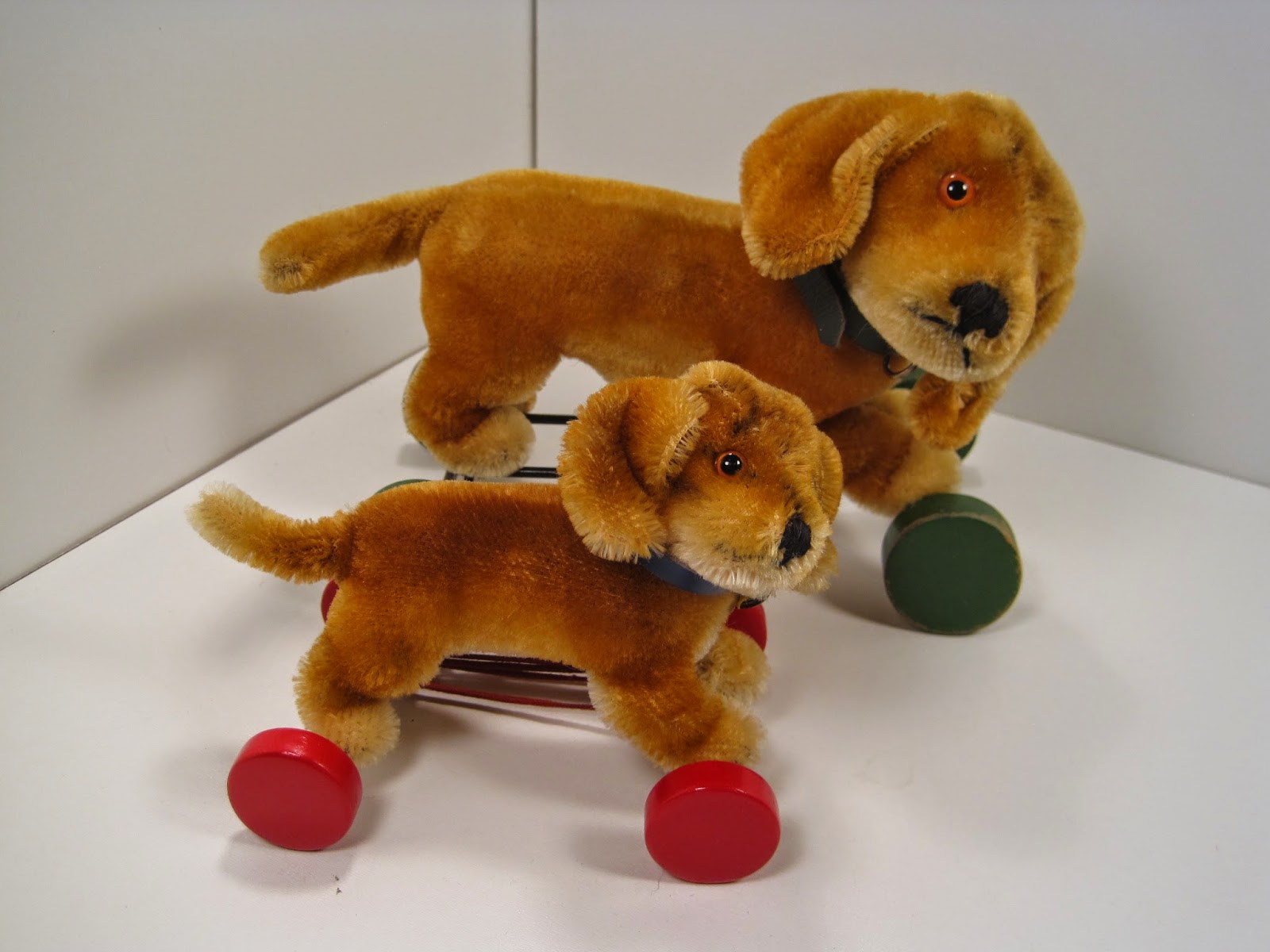 Doxies are a legacy
design pattern for Steiff. They have been in the line almost
continuously since the late 1890's, with the first version debuting in
felt in 1897. This is easy to understand - this breed is especially
beloved in Germany, and it seems as if the Steiff family themselves had a
particular affinity for them as well! Steiff's first named long haired
mohair Doxie, Waldi, debuted in 1933 and was an immediate sensation.
Prewar, he was produced standing, sitting, as a hunter dog-doll, and on
wheels. It is interesting to note that from what Steiffgal can
calculate, Waldi has the honor of being the dog pattern with the longest
history of production in the Steiff line. He appeared pretty much
continuously in the line from 1933 through 1980 - for a total of 47
years. (Molly the puppy is a close second, with a total of 44 years.) An early
standing Waldi is pictured here on the left.
Doxies are a legacy
design pattern for Steiff. They have been in the line almost
continuously since the late 1890's, with the first version debuting in
felt in 1897. This is easy to understand - this breed is especially
beloved in Germany, and it seems as if the Steiff family themselves had a
particular affinity for them as well! Steiff's first named long haired
mohair Doxie, Waldi, debuted in 1933 and was an immediate sensation.
Prewar, he was produced standing, sitting, as a hunter dog-doll, and on
wheels. It is interesting to note that from what Steiffgal can
calculate, Waldi has the honor of being the dog pattern with the longest
history of production in the Steiff line. He appeared pretty much
continuously in the line from 1933 through 1980 - for a total of 47
years. (Molly the puppy is a close second, with a total of 44 years.) An early
standing Waldi is pictured here on the left.  Most likely due to the
success and popularity of Waldi, Steiff introduced a new Doxie named Bazi design
right after the factory reopened for toy making business in the late
1940's. Two versions were produced - a sitting Bazi and a standing Bazi
on wheels. Both were head jointed and made from artificial silk plush
which was highlighted with brown and coppery highlights. Sitting Bazi
was made in 14 and 17 cm from 1948 through 1949, while Bazi on wheels
was produced in 14 cm in 1949 only. And, because of their era of
production, these silk plush versions may have a number of Steiff's
buttons, including a short or long trailing F button or a blank button.
Sitting silk plush Bazi is pictured here on the left; this particular
example has a blank button.
Most likely due to the
success and popularity of Waldi, Steiff introduced a new Doxie named Bazi design
right after the factory reopened for toy making business in the late
1940's. Two versions were produced - a sitting Bazi and a standing Bazi
on wheels. Both were head jointed and made from artificial silk plush
which was highlighted with brown and coppery highlights. Sitting Bazi
was made in 14 and 17 cm from 1948 through 1949, while Bazi on wheels
was produced in 14 cm in 1949 only. And, because of their era of
production, these silk plush versions may have a number of Steiff's
buttons, including a short or long trailing F button or a blank button.
Sitting silk plush Bazi is pictured here on the left; this particular
example has a blank button. Bazi took the collector's world by storm in 1950, and remained a constant in the production line through the mid 1970's. The early 1950's could be called "the dogs days of Steiff" as this was the time when many new named dog patterns - like Snobby the Poodle, Dally the Dalmatian, and Sarras the Boxer - were introduced as mohair became more readily available on a commercial scale again. Starting in 1950, Bazi was made sitting, standing, on wheels, as as a press and release music box, and as a dog-doll. You can see these blue-ribbon buddies pictured below.
Sitting mohair Bazi was was produced in 10, 14, and 17 cm from 1950 through 1969. These are very early examples with their red imprinted chest tags and earliest article numbers. The small one also has his US Zone tag.
Standing mohair Bazi was produced in 10 and 14 cm from 1950 through 1975. Like his brothers pictured above, this is a very early example.
Standing mohair Bazi on wooden eccentric wheels was produced in 10 and 14 cm from 1950 through 1961. This model rides upon four off-center wooden wheels and has the appearance of bobbing up and down as it is pulled along.
Musical mohair Bazi was produced in 25 cm in 1950 and 1951 only. Please click here to learn more about this really interesting item and her full provenance.
Standing mohair Bazi dog-dolls were produced in 25 cm from 1950 through 1954. Please click here to learn more about the story behind this very sweet Bazi couple.
Steiffgal hopes this review of Steiff's beloved Bazi pattern has been as refreshing as a breath of spring air for you!
Have a question about one of your Steiff treasures? Let's talk! Click here to learn more.














